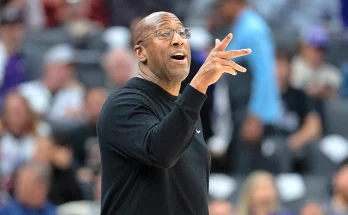When the Chicago Bears were on the clock late in the first round of the 2025 NFL Draft, fans and analysts alike speculated what direction they might go after taking USC quarterback Caleb Williams with the No. 1 overall pick. Would they double down on the offensive line? Grab another weapon at wide receiver? Opt for a defensive playmaker? Instead, general manager Ryan Poles and head coach Matt Eberflus surprised some and thrilled others by selecting Michigan tight end Colston Loveland—immediately giving Williams a dynamic, reliable target in the middle of the field.
Loveland, a 6-foot-5, 245-pound force out of Michigan, was widely regarded as the top tight end in the draft and a first-round talent. His combination of size, speed, route-running ability, and blocking prowess made him a versatile weapon during Michigan’s national championship season. For the Bears, the pick wasn’t just about adding a pass-catcher. It was about shaping the future of their offense around players who can complement each other—and grow together.
“We had a few directions we could have gone,” Poles said after the pick. “But Colston was high on our board from the start. He’s smart, he’s tough, and he’s a complete tight end. He fits what we’re building here in Chicago.”
The selection marks a clear shift for the Bears. After years of offensive inconsistency and instability at the quarterback position, Chicago is now building around Williams with an aggressive, modern approach. Taking Loveland in the first round sends a message: the Bears are prioritizing weapons, versatility, and mismatches.
Loveland, who caught 45 passes for 649 yards and six touchdowns in his final season at Michigan, quickly emerged as one of the Wolverines’ most trusted and explosive offensive options. He became known for his ability to make contested catches, stretch the seam, and seal the edge in the run game. Scouts raved about his football IQ and his willingness to do the dirty work in the trenches.
“I want to be known as someone who does everything well,” Loveland said in a recent pre-draft interview. “Blocking, route-running, leadership—whatever a team needs from me, I’ll give it.”
That mentality is precisely what the Bears are banking on. With Cole Kmet already entrenched as a dependable starter, Loveland brings the potential for two-tight end sets that can both pound the rock and stretch the field. The pairing also gives Williams immediate comfort, especially in the short and intermediate passing game.
“You can never have too many good tight ends,” Eberflus said. “Especially ones who are complete players like Colston. He’s a tone-setter. He’s physical. He brings a mindset to our offense.”
Loveland’s rise to the first round is a testament to his work ethic and development. A four-star recruit out of Idaho, he arrived in Ann Arbor as a lanky, relatively raw athlete with upside. By the end of his sophomore season, he was one of the focal points of a Michigan offense that leaned on him in big moments—particularly in the College Football Playoff.
He caught national attention with a dominant performance against Alabama in the Rose Bowl semifinal, hauling in six catches for 85 yards and a touchdown. Then, in the title game against Washington, he added four more catches and showcased the physical, punishing style of play that endeared him to NFL scouts.
“He’s a grown man on the field,” one AFC scout said during the pre-draft process. “You watch the tape, and he’s throwing linebackers out of the club one play and then splitting the safeties down the seam the next. That’s rare.”
For a Bears team looking to maximize its new franchise quarterback, Loveland is a pick that not only makes sense but has long-term implications. He’s not a project or a specialist—he’s a player who can step in from Day 1 and contribute. His presence will allow offensive coordinator Shane Waldron to open up the playbook with creative formations and motion packages, while also giving Williams a reliable safety valve against NFL defenses.
“You give a young quarterback a tight end like Colston Loveland, and you’re setting him up for success,” ESPN’s Mel Kiper Jr. said during the broadcast. “This kid is NFL-ready. He’s smart, he’s physical, and he’s going to make life easier for Caleb Williams in year one.”
The Bears’ fanbase, already energized by the addition of Williams, now has another reason to be excited. The vision is clear: surround the quarterback with weapons, protect him, and build a system that emphasizes balance and explosiveness. Loveland checks all those boxes.
From a character standpoint, Loveland also fits Chicago’s culture. He was a leader at Michigan, known for his accountability and willingness to lead by example. Coaches and teammates frequently praised his consistency and his team-first mentality. That attitude was on display on draft night, as Loveland remained calm and humble even as the cameras rolled and the emotions ran high.
“Just getting the call—it was emotional,” Loveland said shortly after being drafted. “I had my family with me, and to hear the Bears wanted me…it was surreal. I’m ready to get to work and be part of something special.”
In many ways, the selection of Loveland continues a trend in the NFL of valuing complete tight ends in the first round. With more teams deploying tight ends as essential pieces of their offensive architecture—not just red zone weapons but versatile playmakers—the value of the position has risen. Loveland represents the modern mold: fast enough to threaten defenses down the field, big enough to win contested catches, and tough enough to hold his ground in the run game.
Some compared him pre-draft to former All-Pro tight end George Kittle—a comparison Loveland doesn’t take lightly.
“Kittle’s a monster,” Loveland said. “He plays the game the right way. If I can have a career like his, that’d be a dream. But I’ve got to put in the work.”
That work begins in Chicago, where the expectations will be high, but the opportunity is real. With a young core forming on offense—Williams at quarterback, DJ Moore and Keenan Allen at receiver, a strengthened offensive line, and now Loveland at tight end—the Bears are building something that feels new, dynamic, and dangerous.
And while there’s still plenty of football to be played, and plenty of learning to do, there’s no question that the Bears walked away from the first round with a haul that could redefine the future of the franchise.
Colston Loveland isn’t just another draft pick.
He’s part of a plan.
He’s part of the future.
And in the eyes of the Chicago Bears, he’s exactly where he belongs.


